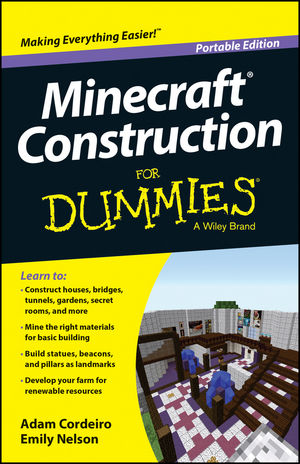
I have recently reviewed three books in the … for Dummies, Portable Edition series and each was easy to recommend as a beginners’ guide, a reference book and a guide to advanced topics respectively. The final book I’m looking at right now is harder to make a case for, as the book seems to have a less well-defined purpose.
Minecraft Construction for Dummies, Portable Edition is all about building things. In a nutshell, so is Minecraft! So this book has a little bit about everything: mining, farming, crafting, redstone circuits, all of these are covered in the context of building your world whilst playing the game.
The main content of the book is a compendium of hints and guidelines for building things in Minecraft. Some of it strikes me as really, really obvious, but at the same time there are some really good ideas mixed in. I liked the instructions for building curved and circular walls, for instance. On the other hand, there are places where useful information is omitted: for instance, the chapter on lighting should give guidance on how to ensure that your lighting is sufficient to prevent mobs from spawning.
What I had hoped for was examples of well-constructed completed builds, as well as guidelines on how to build in different aesthetic styles (medieval, modern etc.) but neither of these is covered.
Instead, this book is really a compendium of general tips and information, organised in no real pattern or structure. Compared to other books of that type that I have seen, Minecraft Construction for Dummies, Portable Edition has far more content, and with a much higher standard in terms of writing style, accuracy, and relevance to the game as it is in 2014. The index is comprehensive, so if you’re stuck for ideas it will often be rewarding to look things up there.
Minecraft Construction for Dummies, Portable Edition is not the focused guide to building styles that I had hoped it might be, but there’s still useful, interesting content tucked away here.
Minecraft Construction For Dummies, Portable Edition
by Adam Cordeiro & Emily Nelson
Wiley, 224pp
